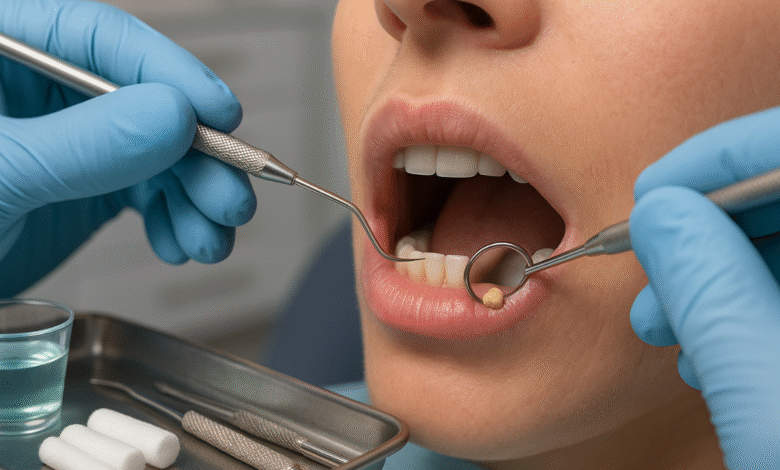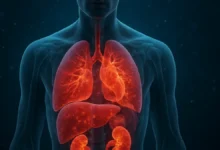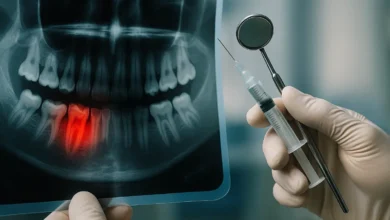Food Stuck in Gums – Causes, Relief, and Prevention for a Healthier Smile

Struggling with food stuck in gums? Discover expert tips on causes, relief methods, home remedies, and prevention for gum health. Learn when to see a dentist for safe removal and lasting oral comfort.
Understanding Why Food Gets Stuck in Gums
Getting food stuck in your gums can be both irritating and concerning. It usually happens when small food particles—like popcorn kernels, seeds, or fibrous meat—get lodged between teeth or under the gumline. This isn’t just uncomfortable; it can also lead to inflammation, infection, or gum damage if not handled properly.
Food impaction often occurs because of gaps between teeth, gum recession, or misalignment. When these spaces develop, they act like tiny traps for food debris. Even healthy gums can experience occasional trapping, especially after eating sticky or fibrous foods like steak or spinach. Understanding what causes this problem is the first step to preventing it.
Common Causes of Food Stuck in Gums
1. Gum Recession and Tooth Gaps
As we age or develop gum disease, our gums can recede, exposing more of the tooth surface and creating small gaps. These pockets easily trap food particles. Similarly, missing teeth or naturally spaced teeth can contribute to frequent food impaction.
Receding gums often come from brushing too hard, smoking, or poor oral hygiene. Once the gumline pulls away, bacteria and debris find easy access, causing irritation or infection if left untreated.
2. Dental Work and Poor Fittings
Dental fillings, crowns, or bridges that don’t fit perfectly can leave tiny crevices where food gets stuck. These small imperfections can be hard to clean, allowing plaque and bacteria to accumulate over time.
If you often feel discomfort or pressure in one area after meals, it may indicate that your dental restoration needs adjustment. Consulting your dentist early can save you from inflammation or gum infection.
How Food Stuck in Gums Can Affect Oral Health
When food remains lodged under the gums, bacteria begin to break it down, releasing acids and toxins. This can irritate the gum tissue and cause redness, swelling, and bad breath.
Over time, this situation can escalate into gingivitis or periodontal disease. Chronic inflammation weakens the supporting bone and tissue around teeth, making them more susceptible to decay or loosening. Therefore, what starts as a small irritation can quickly become a serious oral health concern.
Signs That Food Is Stuck in Gums
Sometimes, you may not immediately notice food stuck in your gums. However, your body sends several warning signs:
- Persistent gum irritation or swelling
- Sharp pain when biting down
- Foul taste or bad breath
- A feeling of pressure between teeth
- Sensitivity near one specific area
These symptoms suggest that something is trapped under the gumline. Ignoring them can cause further infection or decay, especially if plaque accumulates around the area.
Immediate Relief When Food Is Stuck in Gums
Use Dental Floss Correctly
Gently slide dental floss between your teeth in a back-and-forth motion. Avoid snapping it, as that can injure your gums. Waxed floss tends to glide more easily, helping remove particles without causing pain.
If the food remains stuck, try looping the floss around the tooth and pulling upward along the gumline. This method often works for stubborn debris lodged under the gums.
Rinse with Warm Salt Water
Mix half a teaspoon of salt in a cup of warm water and swish it in your mouth for 30 seconds. Saltwater acts as a natural antiseptic, reducing inflammation and dislodging small particles.
Repeat the rinse several times a day to soothe the area and prevent bacteria from growing. It’s a safe and effective home remedy that works for most mild cases.
Safe Home Remedies for Food Stuck in Gums
| Remedy | How It Helps | How to Use It |
|---|---|---|
| Interdental Brushes | Cleans tight spaces between teeth | Gently move back and forth between gaps |
| Water Flosser | Uses pressure to dislodge trapped food | Aim at the affected gum area after meals |
| Hydrogen Peroxide Rinse | Reduces bacteria and inflammation | Mix 1 part peroxide with 2 parts water, rinse 1–2 times daily |
| Baking Soda Paste | Neutralizes acids and soothes gums | Apply lightly to the affected area and rinse |
These methods help maintain clean gums without causing irritation or damage. However, if discomfort persists, it’s best to visit a dental professional.
When to See a Dentist
If food gets stuck frequently or the area becomes painful, swollen, or infected, professional help is essential. A dentist can safely remove debris and identify underlying issues such as cavities, gum pockets, or misaligned teeth.
In some cases, they might recommend scaling and root planing—a deep cleaning procedure—to remove bacteria buildup below the gumline. Timely dental care prevents minor gum irritation from turning into chronic gum disease.
Preventing Food from Getting Stuck in Gums
Maintain Proper Oral Hygiene
Brushing twice daily with a soft-bristled toothbrush helps remove surface debris and plaque. Use a fluoride toothpaste and pay special attention to gumline areas. Flossing once a day ensures no food remains between teeth.
Electric toothbrushes with angled heads can also be more effective in cleaning tight spaces. Remember to replace your toothbrush every three months or sooner if bristles fray.
Choose Foods Wisely
Sticky, fibrous, or hard foods like popcorn, meat fibers, and seeds are notorious for getting lodged in gums. Cutting these into smaller pieces and chewing carefully can reduce impaction.
Hydrating throughout the day also helps maintain saliva flow, which naturally washes away food particles and bacteria.
Expert Advice: Dealing with Persistent Gum Food Traps
Sometimes, the problem isn’t about what you eat—it’s about your dental structure. If you have misaligned teeth, deep pockets, or old restorations, your dentist might suggest corrective procedures.
Orthodontic treatment, gum grafts, or recontouring may help close gaps and reduce the risk of recurring impaction. Regular check-ups ensure your oral health remains stable and free from hidden food debris.
Understanding the Role of Saliva
Saliva plays a major role in preventing food from sticking to gums. It acts as a natural lubricant, washing away tiny food particles and neutralizing acids.
Dehydration, certain medications, or stress can reduce saliva flow, leading to a dry mouth and higher risk of impaction. Drinking plenty of water and using sugar-free gum can stimulate saliva production, keeping gums clean and protected.
How Gum Health Reflects Overall Wellness
Healthy gums are vital for more than just a bright smile—they’re connected to your overall health. Chronic gum irritation from food impaction can contribute to systemic inflammation.
Research shows that untreated gum infections may increase risks for heart disease, diabetes, and respiratory issues. Therefore, dealing with food stuck in gums promptly is essential not only for oral hygiene but for your overall well-being.
Quotes from Dental Experts
“The biggest mistake people make is using sharp tools like toothpicks or pins to remove food from gums. This can push debris deeper or injure soft tissue,” says Dr. Maria Cortez, DDS.
“Consistent flossing is more powerful than most realize. It’s not just about removing food—it prevents bacterial buildup that leads to gum disease,” adds Dr. Kevin Lee, a periodontist.
How to Care for Gums After Food Removal
After successfully removing food, your gums may feel sore or tender. Use a mild antiseptic rinse or aloe vera gel to calm irritation.
Avoid hard or crunchy foods for a few days and keep the area clean. Gentle brushing with a soft toothbrush will help the gums heal naturally while preventing infection.
Long-Term Dental Habits for Gum Protection
- Floss before brushing to loosen trapped particles.
- Schedule professional cleanings every six months.
- Avoid aggressive brushing that damages gum tissue.
- Replace ill-fitting crowns or fillings immediately.
- Use mouthwash with antibacterial properties daily.
By maintaining these habits, you significantly lower the risk of recurrent food impaction and promote lifelong gum health.
Table: Foods Most Likely to Get Stuck in Gums
| Food Type | Examples | Reason for Sticking |
|---|---|---|
| Fibrous Foods | Spinach, celery, meat fibers | Thread-like texture clings to gums |
| Seeds & Kernels | Popcorn, sesame, strawberry seeds | Small size lodges under gumline |
| Sticky Foods | Caramel, toffee, dried fruit | Adheres to teeth and gaps |
| Crunchy Foods | Chips, nuts, crusty bread | Sharp edges irritate gums |
Frequently Asked Questions
Q:1 Why does food always get stuck in the same spot?
That usually means there’s a small gap, pocket, or loose filling in that area. Food tends to wedge into weak spots repeatedly. A dentist can check if there’s gum recession, decay, or alignment issues.
Q:2 Can food stuck in gums cause infection?
Yes. If left too long, trapped food can attract bacteria that cause infection, swelling, and bad breath. It’s important to clean the area gently and seek professional help if discomfort persists.
Q:3 Is it safe to use a toothpick to remove food from gums?
No. Toothpicks can damage delicate gum tissue and push debris deeper. It’s better to use dental floss, an interdental brush, or a water flosser.
Q:4 How long can food stay stuck before it becomes dangerous?
Ideally, you should remove it within a few hours. Leaving it overnight or longer increases the risk of bacterial infection, swelling, and gum bleeding.
Q:5 Can salt water remove food stuck in gums?
Yes, warm salt water can help dislodge small particles and reduce inflammation. It’s a safe, natural remedy that also helps kill bacteria.
Conclusion
Food stuck in gums may seem like a small issue, but it can quickly lead to discomfort, infection, or gum disease if ignored. Understanding the causes, practicing good oral hygiene, and using safe removal methods are key to maintaining a healthy smile.
When in doubt, always consult your dentist—because taking care of your gums today ensures stronger, healthier teeth for years to come.





